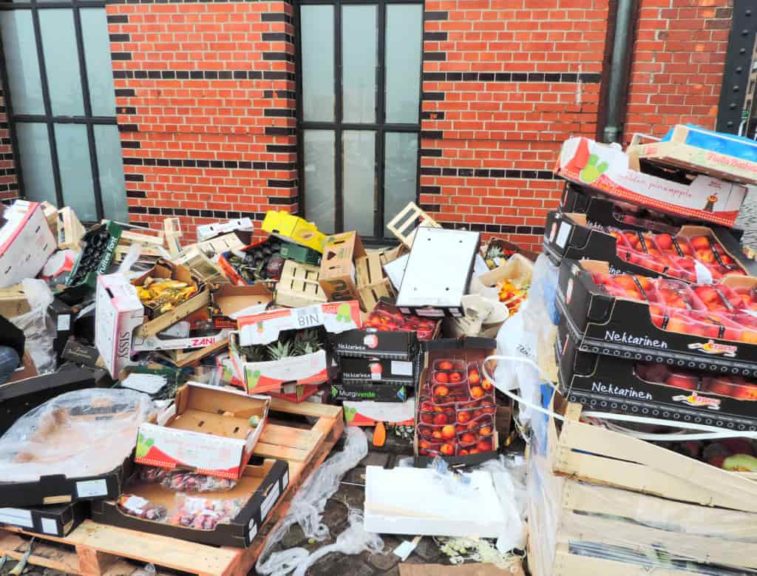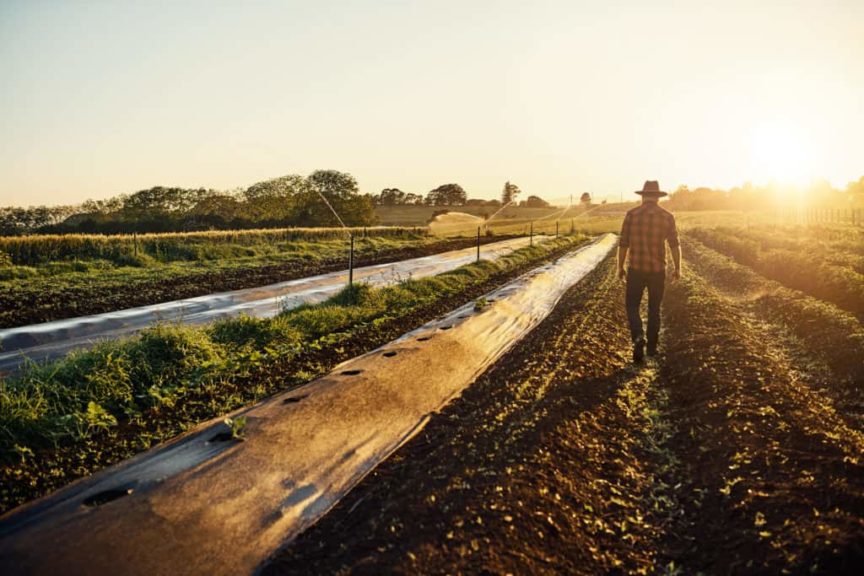We Can Easily Solve The Problem of Food Waste

Imagine yourself at the grocery store, in the produce aisle, sorting through the fruits and vegetables you wrote down on your shopping list for the week. You sift through bunches of broccoli or piles of apples and pears, ignoring those with blemishes and scratches, searching for only the ripest and most appealing specimens. But this behavior is part of a massive problem that is contributing to global hunger, climate change and agricultural instability. The good news is we can solve this problem by teaching current and future generations simple methods on how to reduce food waste; the question is will we?
Why Food Waste is a Problem
Throughout the world, there are nearly a billion people who are considered starving or food insecure, meaning they do not always have access to a sufficient quantity of nutritious food. But there is more than enough food produced in the world to ameliorate this issue, so much that if we were to redistribute a quarter of the food that is wasted in the world, the problem would be solved.
This waste issue is pandemic and can’t really be pinpointed on one nation or another, though developed countries are undoubtedly the largest contributors. In Europe and North America, each year we average between 95-115 kg of wasted food per person. Developing countries like many in sub-Saharan Africa typically waste a tenth or less than that, but still contribute to avoidable food waste when it comes to production and distribution from poor infrastructure and equipment.
In Europe, 29 million tons of dairy products are wasted each year and in the UK alone food waste totals 7.3 million tons annually. In South America, Argentina wastes 1 kg of food per person, daily. Clearly this problem transcends borders, politics, and culture, but it is also one that will likely require some international cooperation to solve at an aggregate level.
So, how does the U.S. stack up? Despite our relative affluence, 14% of families in the U.S. are considered food insecure. Meanwhile, we spend between $1,500 – $2,275 per family, on easily avoidable food waste cost every year. This stems partly from the fact that we throw away nearly half of all produce that we buy, adding up to roughly $160 billion a year. This problem is not solely an American issue, but there are definitely some systemic factors that contribute to these food waste statistics.

Avoidable Food Waste
Much like our society’s unattainable standards for a person’s physical beauty, we tend to overvalue the physical beauty of fruit and vegetables. In reality, we’re missing out on what really counts; that which can only be found on the inside. In the U.S. and other first-world countries we have ridiculously high and often completely irrational standards for what our food looks like.
This fickle and picky attitude is a lead cause of food waste, yet it is one of the easiest issues to solve. Because of these demands, farmers’ harvests are subjected to untenable standards and levels of scrutiny for what their product must look like, despite the fact that slightly less appealing produce, often with only minor blemishes or discoloration, will have the same exact nutritional value. Farmers must carefully weigh the cost and potential revenue that can be made from harvesting a crop, based on whether or not the produce will fit these absurdly high standards. They must take into consideration the labor for harvesting, energy for storing and refrigeration, and the cost of transportation once their product has finally been purchased.
If a crop is not going to cover those costs and turn a profit, farmers reject them as “walk-by” crops. Depending on market demands and weather conditions that year, walk-by’s can occur between 1-30% of the time. These factors in the past have led the price of certain crops to fluctuate so drastically that farmers have to essentially gamble on what will be their cash crop each year. According to one farmer, prices of broccoli have ranged from $6 per case one year, to $32 per case another year.

But there are other, more systemic difficulties in each step of the farmer’s process that are not immediately obvious to those unfamiliar with the industry. While there are plenty of farmers, with plenty of produce, there are a small group of buyers who continue to perpetuate the high standards of what produce must look like. These large corporations, which buy the majority of produce in the US, dictate the standard which farmers must attain, leading them to plant more than they normally would, subsequently leading to more wasted food. But those who cannot keep up with the increasingly high demands end up being muscled out by bigger farms or using GMOs and excessive pesticides to maintain that perfect appearance.
Reducing Food Waste and Expired Food
Another issue we struggle with is our labelling of products with “best-by,” “sell-by,” and “use-by.” These labels all have different meanings, and despite the common misconception that they have to do with the safe consumption of a food product, they actually have to do with a producer’s suggestion of when they will taste best. Sell-by is aimed at when retailers should ideally get the product off their shelves, but beyond that date the product is still good for about a third of its shelf life. Use-by and best-by are both guesses at when the product will remain at peak quality, but don’t necessarily mean the product is bad after that date. In fact, there are only a few products like deli meats and unpasteurized dairy products that are highly perishable and dangerous to consume immediately after the use-by date.
As it turns out, the majority of consumers can’t tell the difference between these labels, let alone the fact that they are, to a varying degree, guesses at when the food is likely to taste the best. One study found that less than half of all consumers can properly identify what the term sell-by means, while less than a quarter could identify what use-by means. At this point, 90 percent of us will throw away food once it has reached this date, adding up to $1,500 or more in the trash each year.

Not only does that food, which ends up in the trash, waste money, it also makes up 20 percent of our landfills. When this is compounded with the amount of energy and water spent on production, food waste accounts for nine percent of global greenhouse gas emissions. In the U.S. it accounts for a quarter of all freshwater use, tens of millions of acres of cropland, and 300 million barrels of oil each year; a large contributor to climate change, with one of the easiest fixes.
While there are some efforts being made by certain groups like the Consumer Goods Forum, there should be a broader mandate to label food in a clear and concise way, making it clear to consumers when their food is perfectly safe to eat. It wouldn’t be a stretch to say that it’s within corporate interests for consumers to waste food and this is probably the reason that labels are so ambiguous in the first place. When companies can convince you that the perfectly good food in your fridge is unfit for consumption, this leads the consumer back to the store to buy more.
This has also led for some to call out corporations for practices like multi-buy offers, that can be deceitful and convince consumers to buy more than they need. Multi-buy offers, like those that offer a discounted price when you buy 2 or more, often sound like a bargain, but lead to wasted food and are sometimes more expensive than buying the product at its unit price. A study found that companies would often use “zig-zag” pricing to make a product seem like it was being sold at discount, when it was previously sold at an inflated price for only a couple days.
Ways to Reduce Food Waste
In Denmark, one woman has been credited with drastically reducing food waste throughout the entire country. Selina Juul was originally born in the Soviet Union making her accustomed to food shortages. After moving to Denmark, she became appalled by the country’s rampant waste of food and decided to make it her goal to implement a solution. She convinced a local grocery to practice policies like eliminating multi-buy offers and selling individual bananas rather than bunches, to sell the hundreds of pieces of fruit that were otherwise being thrown out.
Ironically, Juul targeted a grocery store called REMA 1000, a Norwegian chain that is known for its “no-frills” aesthetic, displaying produce on wooden pallets and crates and limiting its stock to 1000 items. The chain is particularly popular for its low prices and hundreds of locations. Garnering over 17 percent of all revenue from supermarkets in Scandinavia, it was inspired by the successful business model of the German supermarket chain, ALDI.
Over five years, Juul’s methods worked and she cut food waste by 25 percent throughout Denmark. She first inspired REMA 1000, creating a trend in the private sector, which subsequently led to policy changes at the public level. With enough support and demand her model could become a worldwide trend.
Another idea that Juul put into action was a food waste supermarket. In its first week, the store was donated 40 tons of food that would have otherwise been thrown away, selling it for half the price it could be found at a normal grocery store. The food waste market became so popular they had to open another, soon inspiring similar models in the UK and other countries.
But could something like this happen in the US? Unless there is a large movement to enact changes in legislation, it would be difficult to follow this model. Unlike in France, where laws have been passed that prohibit restaurants and markets from throwing out unsold food, the U.S. has stricter laws and picky consumers. But if we collectively demand a different model and use our purchasing power to change these business dynamics we could implement some similar practices and lower food waste. Doing so would save us all money, reduce the damage being done to the planet, and prevent people from going hungry. So, what are we waiting for?
How Cryptocurrencies Like Bitcoin Can Democratize Money and Society

As cryptocurrencies like Bitcoin break new records seemingly every day, could this lead to a financial and cultural revolution? Or are we not quite there yet?
Cryptocurrencies have recently gained popularity as an alternative to conventional monetary systems. Blockchain is a system in which a record of transactions made in Bitcoin and other cryptocurrencies are maintained across multiple computers that are linked in a peer-to-peer network. Cryptocurrency has no centralized bank controlling the flow of money, but rather a decentralized system controlled by algorithms.
Crypto has been hailed as a way to democratize finances for all, not just wealthy elites. But with the rise in popularity, what are the potential pitfalls of these online currencies?
“Blockchain is a way of digitally marking the development and moving around of this money—you’re making sure that it can’t be counterfeited. They do it in such a way that it’s anonymous and decentralized, but secure,” Zeus Yiamouyiannis, author of Transforming Economy, said.
“The current monetary system can be manipulated; the supply can be manipulated to benefit very few people over the many. As we’ve been seeing over the past few decades, the same pattern keeps emerging and it’s growing, and that is greater and greater gambling by the big boys, to the point where they inherently fail through their greed. And guess who bails them out 100 percent of the time? The little guy who had absolutely nothing to do with it,” Yiamouyiannis said.




































